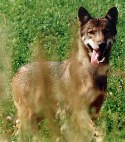It is ironic that dogs—"man's best friend"—should be so closely related to wolves, who are the object of such fear, prejudice and misunderstanding. The idea of the "big bad wolf" is largely a myth.
In general, wolves steer clear of humans (indeed, this is one reason why their trophy value for hunters is so high). Over the past half century in Slovakia, there has been only one proven wolf attack on a human from 1951, when a wolf turned on a shepherd who was trying to drive it away from a kill. A number of people are shot accidentally by hunters every year, yet it is wolves, not hunters that loom large in the popular imagination.
"It's an irrational fear," says Mojmir Vlašin, a zoologist working with the Veronica Ecological Institute in Brno in Moravia. "It's a myth that gets fixed in our brains from early age. Never mind that the Big Bad Wolf in "Little Red Riding Hood" does not reflect reality; we carry an irrational fear of wolves with us for life."
Every year, notes Vlašin, people are injured by bears in zoos as a result of sticking their hands into the bears' cages. No such cases exist with wolves. "Our image of bears, from teddy bears to children's stories, is much more favorable than for wolves, for whom we have an innate fear." No one would think of putting their hands into a wolf cage; even if they did, it is unlikely that the shy canines would do anything.
A social animal
In contrast to their bloodthirsty and sinister reputations, wolves have a complicated social system. The highly intelligent and adaptable animals live in packs of three to ten members that observe a strict hierarchy.
A parent couple, referred to as the alpha male and female, leads the pack. Members include both offspring of the alpha couple as well as other individual wolves that have joined the pack. Within the pack, mating is restricted to the alpha couple, while other members share in protecting and raising the alpha couple's offspring. A "beta" wolf serves as a kind of deputy to the alphas and in some cases may replace the alpha female or also mate with the male.
As social animals, wolves have a well-developed system for communicating, including barks and howls, body language and facial expressions. Smells, like scat and urine used for marking territories, is also important.
In summer, when food is plentiful, the pack usually becomes looser as some of the individual wolves strike off on their own. As winter nears and food becomes relatively scarcer, the social organization of the pack becomes tighter; individual wolves join the pack and others return.
Hierarchies within the packs are continuously tested and challenged. The alpha male remains leader as long as he manages to maintain his authority. Challenges to that authority by subordinate members or wolves from outside the pack are usually peaceful, consisting of growls, body language and facial expressions (much the way dogs assert themselves or signal submission), but can be violent and in rare cases even end in the death of one of the two wolves.
Together, the pack covers a wide territory—40 km2 or even greater—carefully demarcated with scat and urine.
With a length of 100-140 cm and weight of 60 Kg, the animals can reach about twice the size of a German shepherd. In most of the Carpathians, wolves hunt mainly wild boars, red and sometimes roe deer and on occasion domestic animals.
Fear of the wild?
The negative image of wolves permeates Judeo-Christian civilization, from the "Bible" ("a wolf in sheep's clothing...") to scores of children's stories and Disney movies. Other traditions have treated the animals more favorably. The ancient Daci, who populated present-day Romania before the Romans arrived two millennia ago, respected wolves for their intelligence and social organization and included wolves on their flags and standards.
We can only conjecture on the origins of our fear of wolves in the mists of Western civilization. Perhaps it is the animal's close association with wilderness, on which it has always depended for survival. As the unknown and uncontrolled, wilderness is fundamentally threatening. The very fact that wolves are seen so rarely enhances their mystery and makes them all the more threatening.
Indeed, it is usually in those areas where people have the least experience with wolves that there are the greatest problems and irrational fears become fanned into hysteria.
Andreas Beckmann, 23 April 2001
Moving on:
- Browse through the CER eBookstore for electronic books
- Buy English-language books on Central Europe through CER
- Return to CER front page
Sources:
Carpathian Ecoregion Initiative: www.carpathians.org
Wolf Forest Protection Movement (Lesoochranárske zoskupenie VLK): www.wolf.sk
Association for Nature WOLF (Stowarzyszenie dla Natury WILK): www.most.org.pl/wolf
Large Carnivore Initiative for Europe: www.large-carnivores-lcie.org




